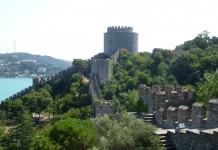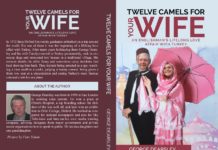
Do you ever wish you could go back in time to experience life during the Ottoman Empire? If so, there is an exhibition at the Koç University Research Center for Anatolian Civilizations (RCAC) that will satisfy your curiosity. The focus of this exhibit is the work of British engraver, photographer and painter, James Robertson. It highlights the work Robertson did on behalf of the Ottoman mint, his photography work throughout the Ottoman Empire, along with a small series of paintings he produced showing daily life in Istanbul.
James Robertson (1811-1888) lived an extraordinary life by any measure. He was born in Britain and worked for the Royal Mint in London as an engraver. Later, Sultan Abdülmecid decided to reform the Ottoman coinage and imported equipment and craftsmen from Britain. Robertson was one of these craftsmen. Robertson worked for the Ottoman Mint from 1844-1877, where he designed and executed 26 different medals. During the 1850s, he began to practice the new fad of photography as a hobby and opened up his first photography studio in Pera.
During the 1850s, Robertson was busy traveling around and photographing various cities in the Ottoman Empire. He traveled to Athens, Cairo, and Jerusalem during this decade. Many of his photographs were shown in contemporary exhibitions. In the 1860s, however, he closed his photography studio and in the 1870s he did some of his last work for the Ottoman Mint. He officially retired from the mint in 1881, after serving under four different sultans. Shortly, thereafter, he departed for Japan, where he spent the remainder of his life.
The exhibition consists of two rooms. The first, smaller room is right as you enter and has a timeline describing the major events of Robertson’s life as well as reproductions showing his work at the Ottoman Mint. What is amazing about his work is the detail that went into crafting Ottoman medals. The medals show various locations around the empire including Bosnia, Crimea, and Yemen. You get a sense of how enormous and geographically diverse the Ottoman Empire was during the 19th century. In the same room, financial documents and an original medal from 1849 depicting the Aya Sofia, are on display.
The second, larger room focuses on Robertson’s skills as a photographer and painter. Here is where you can really go back in time to see daily life during the Ottoman Empire. This room also contains original books documenting Robertson’s work. The work shown in this room features scenes from Istanbul, Athens, Cairo, and Jerusalem. What struck me in the photos of Istanbul were the vast open spaces of the city, especially when contrasted with the paucity of people. Even in centrally and historically significant areas such as Sultanahmet, there are very few people occupying an enormous space. Perhaps if he had taken photographs in Pera, the scenes would have been full of people illustrating the hustle and bustle of city life at the time.

Many of his photographs of Istanbul focus on buildings and views. This is particularly evident in his tremendous 360 degree view of Istanbul taken from Beyazit Tower (at Istanbul University). This photograph (in five parts) shows a wonderful view of Istanbul, where you can see old wooden houses and imperial mosques, along with the wooded area of Sarayburnu.
Although there are only a few on exhibit, Robertson’s paintings are also quite illuminating. Robertson painted everyday scenes featuring the residents of Istanbul, including simit sellers and dervishes. One interesting example of Orientalism is seeing Robertson paint himself along with a relative wearing Ottoman dress. Orientalism (which was a theme of an earlier exhibition at the Sabanci Museum) can appear as a sub-theme here, particularly with Roberton’s paintings of colorful characters and veiled women. One wonders if he produced any other paintings and, if so, how they would compare and/or contrast with his work on display here.
Robertson’s photographs of Ottoman (and in the case of Athens) formerly Ottoman cities is interesting in that as with Istanbul, you get the sense of an immense space, inhabited by a small number of people. There are very few people occupying the city streets in Jerusalem and Cairo. Athens is notable in the fact that there were only 30,000 people living in the city during the decade that Robertson visited it.
One of Robertson’s main achievements was being one of the first war photographers in history. Based in Istanbul, Robertson was able to easily access and photograph the Crimean War (1853-1856). His photographs from Crimea show the places of battle, but the viewer is spared the horrors of war (unlike the photographs of the American Civil War taken by Matthew Brady in the following decade).
James Robertson lived an extraordinary life during extraordinary times. He dedicated his life to minting, painting, and photographing, as well as traveling throughout the Ottoman Empire and finally Japan. Both he and his work are worth knowing about and we can be thankful to the Koç University Research Center for Anatolian Civilizations for their meticulous efforts in bringing him to our attention.
Kosta Dalageorgas is a contributor for Yabangee.
“Robertson, Photographer and Engraver in the Ottoman Capital”
November 27, 2013-February 20, 2014
For more information, visit the RCAC website.
Hours:
Tuesday-Saturday: 10:00-6:30
Sunday: 12:00-6:30
Mondays Closed
Admission: Free
[geo_mashup_map]










